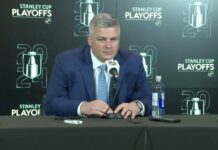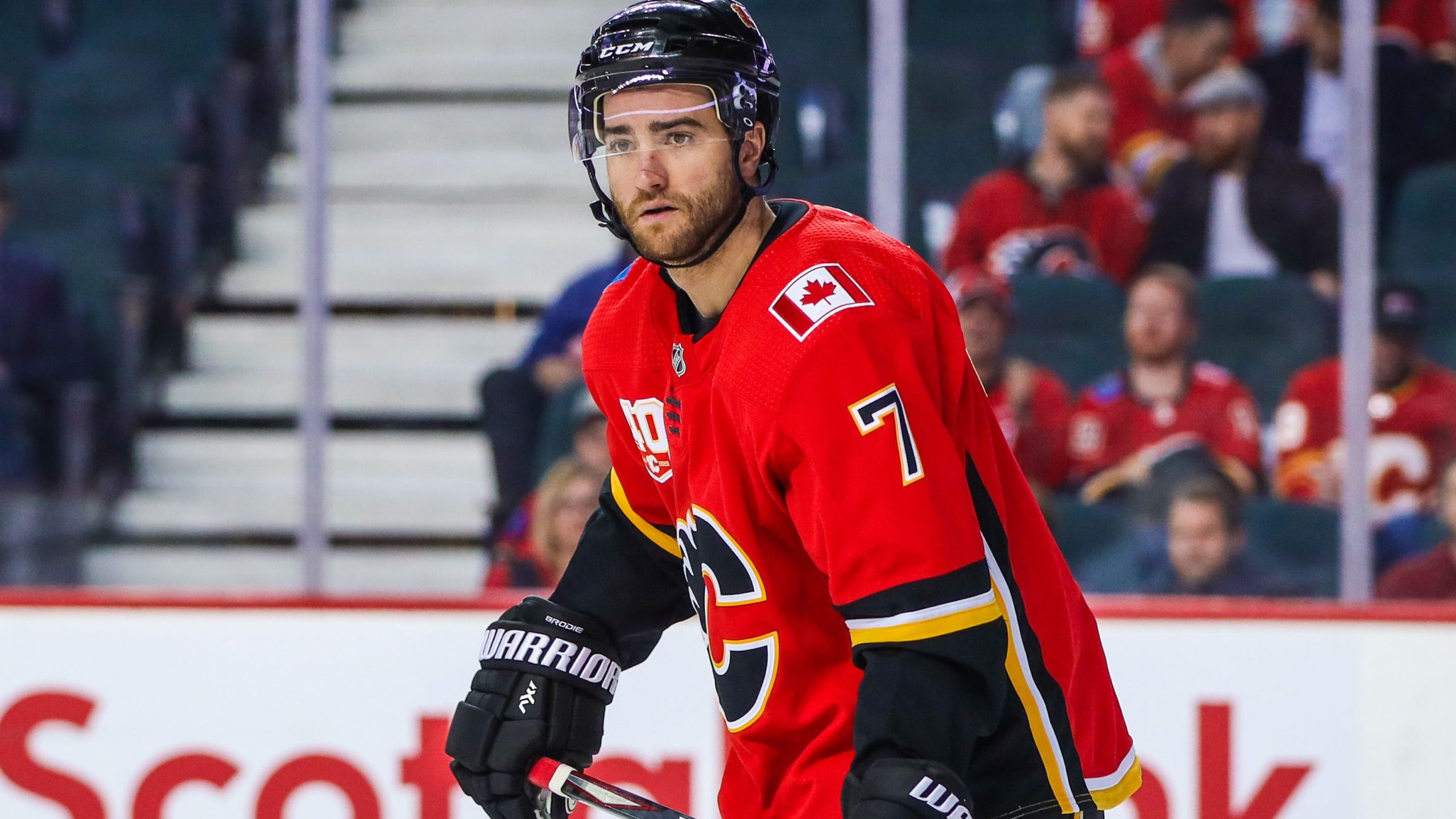You can’t discuss the Toronto Maple Leafs’ offseason moves without touching on this: It is clear now that the Leafs, if they were willing to move heaven and earth to do it, would’ve had a really good shot at landing Alex Pietrangelo.
I am of the mind that the Leafs realistically would’ve had to move William Nylander in order to accommodate Pietrangelo knowing that the cap isn’t only flat for this year but potentially for a few years to come — including when Frederik Andersen’s deal expires, Zach Hyman’s deal expires, potentially when Morgan Rielly’s deal expires. It’s just an opinion and a general feeling more than something I can definitively prove, but I think it would’ve been too challenging to fill the roster out with quality depth year over year.
There is only so much you can get away with when it comes to flipping quality, established NHLers and replacing them with $700k-$1 million UFA signings and younger internal options before you’re playing with fire — if everyone is healthy and performing at optimal levels, it’s a hell of a top-six forward group and top three on defense, but in order to win four rounds in the Spring, the depth lines 1-5 and pairs 1-4 has to be strong.
In doing their due diligence, the Leafs likely weighed up the following:
- Alex Pietrangelo for 7 years at a big number
- William Nylander’s return (unknown)
OR
- TJ Brodie for 4 years at $5 million
- William Nylander
Kyle Dubas almost certainly had a decent sense of what the market for Nylander was like. This doesn’t mean he was actively shopping him. But do you think when he talked about the Kasperi Kapanen deal with Pittsburgh, Nylander’s name never came up? Or in exploring a number of defense trade options this offseason, he didn’t have discussions about Nylander ever? He probably came up a fair bit. With the exception of the rare player that is an obvious non-starter in conversations (e.g. Matthews), it’s part of the job of the GM to keep his ear to the ground, have open dialogue with other managers, and generally maintain a sense of your players’ value in the market, however highly valued and unlikely to move that player may be.
Unfortunately, we can’t answer the unknown when it comes to a potential Nylander return. However, I really think the latter scenario (the one Dubas opted for) is preferable, for a bunch of reasons.
1) I don’t think Nylander’s return was likely to be commensurate with his on-ice value. The returns we’ve seen on players moved for cap reasons have been quite underwhelming, and while Nylander is so much more than a cap dump — he just bounced back with a really nice 30+ goal season — I am still not sure the market conditions were optimal. While he’s owed a little less salary than his cap number ($6 million per year now for the rest of the day) and plenty of teams should be lining up for his skill set and production at that figure in normal times, it was a strange market and Nylander has a signing-bonus heavy deal all the way through the duration of his contract; the majority of his money will be paid out on July 1 each year ($3.5 million), which isn’t appetizing to every team in this climate. We could also get into the narrative around him created by a lot of fans and media in this market — which I don’t think is everything but also doesn’t help — but that’s a rabbit hole I won’t go down here.
2) Alex Pietrangelo has not spent as much time in the tough-minutes role as TJ Brodie has since Colton Parayko emerged in St. Louis. That’s not to say Pietrangelo isn’t elite and a better player, which he clearly is. But there was going to be a bit of a tug-of-war between Morgan Rielly and Pietrangelo for top-unit PP time, and Pietrangelo has mostly played in behind a great shutdown defenseman in the last few seasons. Brodie, on the other hand, doesn’t really need PP time to thrive, is certainly a credible top-four defenseman with high-end skating and puck-moving ability, and he has managed solid defensive results against good competition (more through defending with his stick and skating than a physical presence, but he’s a highly credible top-four RD in my view). He’s only signed until he’s 34, instead of 37-38, at probably $3.5-4 million less.
The Zach Bogosian add and the overall picture on defense
Before free agency opened, I wrote the following of the Leafs’ depth needs on the backend:
“We aren’t talking about hard-to-get studs here. For instance — and this is said with loads of 20/20 hindsight knowing Barrie was an unforeseen travesty on the ice — the Leafs absolutely would’ve been better off with Ron Hainsey on their blue line over Barrie this past season. Again, we’re not talking about Chris Pronger; simply someone with the ability to cut off an easy passage from the left to right side of the ice behind the net, get in shooting lanes, and box out — and with good support from the forwards, most times able to execute the short pass under pressure that is needed to break out. The Leafs need an experienced defenseman or two who just do those basics well enough consistently enough.”
Zach Bogosian matches this description pretty well. He played in 20 of 24 games for the Lightning in their championship run and played more than 19 minutes in six of those games. He’s a big, strong, and belligerent veteran who is not foreign to healthy scratches and it won’t make a big scene if he is one should he end up settling more in the 7D role for periods of time. I can see him elevating in the lineup and filling a gap short term if there are injuries, should the Leafs need a different look next to one of their puck movers, or if the match up calls for it in the playoffs. I like the Leafs’ mix and depth overall on the backend right now with Rielly-Brodie / Muzzin-Holl / Dermott, Sandin or Lehtonen – Bogosian, with Liljegren and Marincin as call-up options/extras.
There is the potential for any of Dermott, Sandin, and Lehtonen to grow into bigger minutes and bump Holl down. This is a much better situation overall. You need nine or ten NHL defensemen to get through 82 in the regular season and 20+ in the playoffs. They’re better set up if injuries strike as they did last season, and Bogosian and Brodie give them better PK options than what Dave Hakstol had on defense last season.
Much of the discussion after the Brodie and Bogosian adds shifted to the possibility of moving Travis Dermott, but if the Leafs can make it work cap-wise, I would not move Dermott if it can be avoided. Instead, I would approach it like so: Find out if he can enter his age-24 season fully healthy and able to hit the ground running (he’s only played 154 career games), then try him for an extended period on the right side. If he can work his way into bumping Holl down and the Leafs have the option of Holl or Bogosian on their bottom pair, they’ll be sitting in really good shape on the blue line. The Leafs should sit back and let this play out if they can knowing the pieces should fall into place over time.
Overall, I see the blue line as significantly improved. The ideal would’ve been to find a top-four RD with Bogosian’s physical traits and Brodie’s skill set, but those are unicorns. Unlike the bet on Barrie last season, Brodie has spent years playing hard minutes and he does not need power-play minutes spoon-fed to him to keep him engaged and feeling like he’s contributing (which was exacerbated by the pressure on Barrie to produce in a contract year).
The Andreas Johnsson trade was a harsh dosage of cap medicine to swallow, and there are likely more depth moves to come both on the blue line and up front — in my view, the Leafs need a center who is good defensively and could give them another third-line option in addition to Alex Kerfoot, assuming he stays — but Kyle Dubas’ offseason is off to a promising start.


![Jim Montgomery Post Game, Bruins 4 vs. Leafs 2: “[Marchand] still manages to get under people’s skin, yet he doesn’t cross the line” Jim Montgomery, Boston Bruins post game](https://mapleleafshotstove.com/wp-content/uploads/2024/04/jim-monty-pg-to-218x150.jpg)

























![Jim Montgomery Post Game, Bruins 4 vs. Leafs 2: “[Marchand] still manages to get under people’s skin, yet he doesn’t cross the line” Jim Montgomery, Boston Bruins post game](https://mapleleafshotstove.com/wp-content/uploads/2024/04/jim-monty-pg-to-100x70.jpg)






